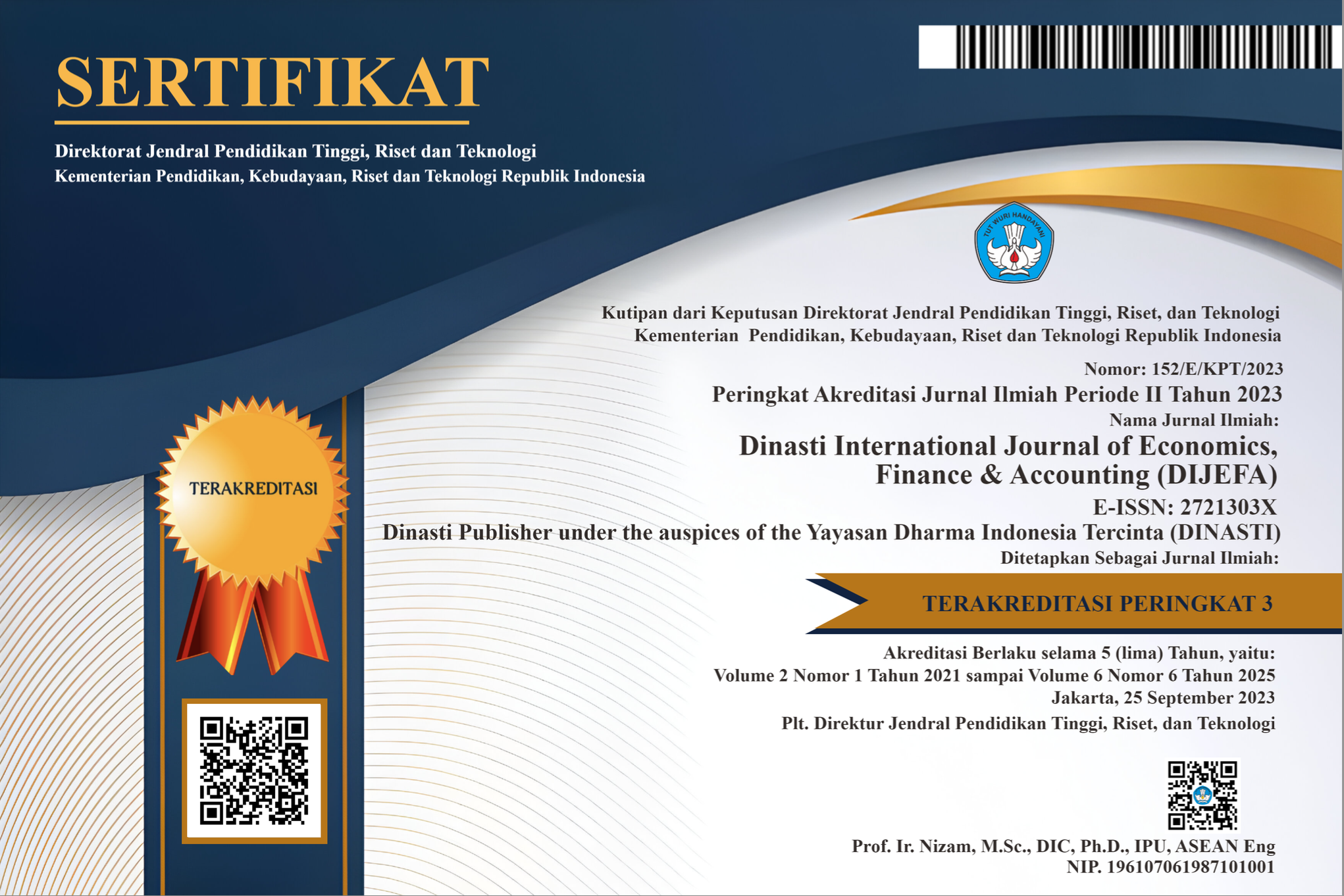The Role of the Green Economy as a Strategy for Improvement Economic Recovery and Multilateral
DOI:
https://doi.org/10.38035/dijefa.v5i3.3207Keywords:
Green Economic, Multilateral, Economic RecoveryAbstract
The economic development has the potential to cause negative impacts on the
environment. Environmental problems that occur urge policies to implement green economy as the most urgent and effective environmental management tool. Methodologically, conceptualizing, implementing, and critiquing the creation of a green economy paradigm towards society leads to the challenge of a global strategy that has the goal of sustainability, poverty alleviation, and inclusion of vulnerable social sectors. The influence of the green economy on the sustainability of life is still in the context of grahita. The purpose of this research is to determine the effect of the green economy on economic recovery and multilateral problems. Research objects in online libraries, Google Scholar, Mendeley and other academic online media. The research method with the research library comes from e-books and open access e-journals. The results of the study reveal that the application of a green economy is capable of driving national economic recovery as well as problems in the multilateral sector. In order for a green economy to be realized for the country, policy makers must be supported by various parties so that a sustainable green economy is formed. A green economy also contributes to maintaining a healthy environment and shaping ecosystems appropriately for present and future generations.
References
A.K., N., & Setiawan, N. (2021). Review Program Pemulihan Ekonomi di Indonesia. Jurnal
Anggaran Dan Keuangan Negara Indonesia.
Aminata, J. (2022). The Analysis of Inclusive Green Growth In Indonesia. Jurnal Ekonomi Dan Studi Pembangunan, 23(1)
Arikunto. (2013). Prosedur Penelitian. Rineka Cipta. Arkas. (2021). The Effect of Private
Investment and Capital Expenditure on Economic Growth and Income Inequality in Bali
Province. American Journal of Humanities and Social Sciences Research, 5(6), 262–267.
Arkas. (2021). The Effect of Private Investment and Capital Expenditure on Economic Growth and Income Inequality in Bali Province. American Journal of Humanities and Social Sciences Research, 5(6), 262–267.
ESCAP. (2014). Green Growth Indicators: A Practical Approach for Asia and the Pacific.
Ilham, M, & Pangaribowo, E.H.(2017). Analisis Ketimpangan Ekonomi Menurut Provinsi di Indonesia Tahun 2011-2015. Jurnal Bumi Indonesia
Hajian, .M., & Kashani, .S.J. (2021). Evolution of The Concept of Sustainability from Brundtland Report to Sustainable Development Goals. Sustainable Resource Management, 1–24.
Hendayana, Y., Suryana, Ahman, E., Mulyadi, H. (2019). Do Technological Capabilities Influence Innovation In Creative Industry: The Case Of Handicraft Sector In Indonesia. International Journal Of Scientific & Technology Research, 8, (08), 1722-1725.
Hendayana, Y., Suryana, Ahman, E., & Mulyadi, H. (2019). The Effect of Innovation on Business Competitiveness of Small and Medium Enterprise in Indonesia. 100(Icoi), 116–120. https://doi.org/10.2991/icoi-19.2019.21
IMF. (2021). Global Real GDP Growth in 2020
Makmun. (2016). Green Economy: Konsep Implementasi dan Peran Kementrian Keuangan. Jurnal Ekonomi, 19(2)
Nazir. (2003). Metode Penelitian. Ghalia Pustaka.
Palmer. (2021). The important of Economy Growth
Pranowo, A. S., Dachi, A., Nasution, N. L., & Hendayana, Y. (2021). The Mediating Role of Innovation Capability in the Relationship between Knowledge Sharing on SMEs’ Performance. Budapest International Research and Business Institute Journal, 4(3), 3890–3899. https://doi.org/10.33258/birci.v4i3.2156
Sarwono, J. (2006). Metode Penelitian Kuantitatif Dan Kualitatif. Graha Ilmu.
Setyo Pranowo, A., Hari Mulyadi, H., Musannip Efendi Siregar, Z., & Hendayana, Y. (2020). The influence of entrepreneurship orientation and management capability on performance of small and medium enterprises in Bogor. Increasing Management Relevance and Competitiveness, 81–84.
UNEP. (2022). Green Economy.
World Bank (2021). Inclusive Green Growth: The Pathway to Suntainable Development in OECD Observer
Zed. (2003). Metode Penelitian Kepustakaan. Yayasan Obor Indonesia.
Downloads
Published
How to Cite
Issue
Section
License
Copyright (c) 2024 Meira Rahmadani, Istianingsih Sastrodiharjo, Yayan Hendayana

This work is licensed under a Creative Commons Attribution 4.0 International License.
Authors who publish their manuscripts in this journal agree to the following conditions:
- The copyright on each article belongs to the author(s).
- The author acknowledges that the Dinasti International Journal of Economics, Finance & Accounting (DIJEFA) has the right to be the first to publish with a Creative Commons Attribution 4.0 International license (Attribution 4.0 International (CC BY 4.0).
- Authors can submit articles separately, arrange for the non-exclusive distribution of manuscripts that have been published in this journal into other versions (e.g., sent to the author's institutional repository, publication into books, etc.), by acknowledging that the manuscript has been published for the first time in the Dinasti International Journal of Economics, Finance & Accounting (DIJEFA).


























































